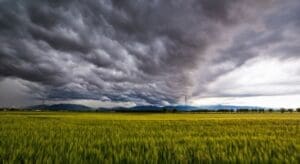By Trish Svoboda
Kansas waterways have been experiencing an unusually early onset of harmful blue-green algae this year. This could be due to the warmer weather in the late spring and increased rainfall, according to Joe Gerken, a fisheries and aquatics specialist from Kansas State University.
Blue-green algae are not actually algae, but a type of bacteria known as cyanobacteria. These bacteria flourish in warm, nutrient-rich water and can form harmful algal blooms, or HABs, under the right conditions.
According to Gerken, the season for HABs appears to begin earlier each year. These blooms usually manifest when water temperatures rise above 75 degrees Fahrenheit, though some species can bloom in cooler seasons.
In water, blue-green algal blooms can often resemble spilled green paint or occasionally, pea soup. The size of these blooms can vary, sometimes only covering a small area of the waterway with minimal visible algae. As the cells decompose, they can emit a swampy odor.
Exposure to harmful algal blooms can lead to illness in both humans and animals. Symptoms of this illness can include vomiting, diarrhea, rash, eye irritation, cough, sore throat, and headache. These symptoms can manifest anywhere from a few hours to two days after exposure.
In addition, water tainted with harmful algal blooms can be lethal to aquatic life. Hence, it is advised that landowners take proper care of their ponds and other water bodies.













